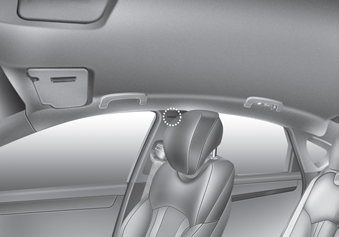Hyundai Genesis: Where are the air bags? / Curtain air bags


Curtain air bags are located along both sides of the roof rails above the front and rear doors.
They are designed to help protect the heads of the front seat occupants and the rear outboard seat occupants in certain side impact collisions.
The curtain air bags are designed to deploy only during certain side impact collisions, depending on the crash severity, angle, speed and impact.
The curtain air bags do not only deploy on the side of the impact but also on the opposite side.
For vehicles equipped with a rollover sensor the side and curtain air bags on both sides of the vehicle may deploy if a rollover or possible rollover is detected.
The curtain air bags are not designed to deploy in all side impact or rollover situations.
WARNING
To reduce the risk of serious injury or death from an inflating curtain air bags, take the following precautions:
- All seat occupants must wear seat belts at all times to help keep occupants positioned properly.
- Properly secure child restraints as far away from the door as possible.
- Do not allow passengers to lean their heads or bodies onto doors, put their arms on the doors, stretch their arms out of the window, or place objects between the doors and seats.
- Do not open or repair the side curtain air bags.
 Side air bags
Side air bags
Your vehicle is equipped with a side air
bag in each front and outboard rear
seat. The purpose of the air bag is to
provide the vehicle's driver and/or the
front and outboard rear passenge ...
 How does the air bags system
operate?
How does the air bags system
operate?
The SRS consists of the following
components:
1. Driver's front air bag module
2. Passenger's front air bag module
3. Side air bag modules
4. Curtain air bag modules
5. Retractor pre-tens ...
Other information:
Hyundai Genesis (DH) 2013-2016 Owners Manual: Inside rearview mirror
Before you start driving, adjust the rearview mirror to the center on the view through the rear window. WARNING Make sure your line of sight is not obstructed. Do not place objects in the rear seat, cargo area, or behind the rear headrests which could interfere with your vision throu ...
Hyundai Genesis (DH) 2013-2016 Service Manual: Injector Specifications
Specification ItemSpecificationCoil Resistance (?)0.98 ~ 1.14 [20°C(68°F)] ...
